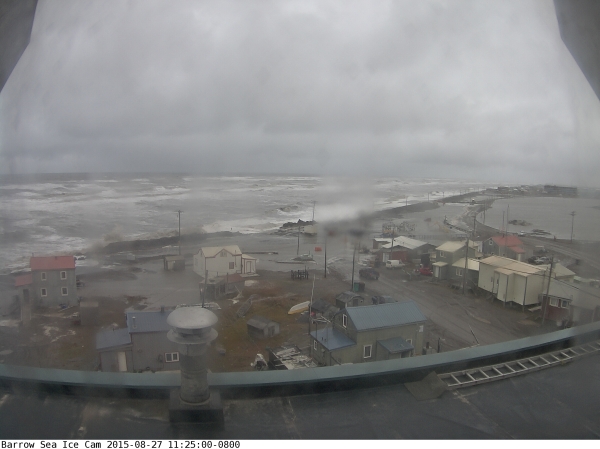This is not something that is normal for typically ice-choked Barrow, Alaska. Today, 25 to 35 mile per hour winds and fetch-driven, 10-15 foot high waves are breaking through coastal barriers and flooding the streets and homes of a town that is used to far more placid seas.
(Recently, Barrow city officials had a barrier of sand erected to protect structures from the newly ice liberated waters of the Beaufort Sea. Today, a strong coastal low pressure system’s surf smashed that barrier, flooded the coastal road, broke a channel through to an inland lake, and swamped numerous structures. Image source: Barrow Sea Ice Webcam.)
* * * * *
There’s been quite a lot of potential storm energy building in the Beaufort Sea this season. Nearby waters in the Chukchi have ranged between 3 and 5 degrees Celsius above average. Warmth, moisture and low pressure systems have flooded in from the Pacific off the back side of the Ridiculously Resilient Ridge to the south. It was a pool of warmth and heat just waiting for a trigger.
As August swung toward September, the near polar regions began to cool even as the Summer sun retreated. Temperature differentials between ice free sections of the Chukchi and Beaufort and remaining ice covered regions in the Central Arctic Basin hit new extremes. And, yesterday, a strong low pressure system began to develop off the Northern Alaskan coast (see video of yesterday’s building surf here).
(Fifteen foot waves north and west of Barrow, Alaska as detected by Earth Nullschool at 2:05 PM EST on August 27th. Image source: Earth Nullschool.)
In response, Alaska weather forecasters yesterday issued a High Surf Advisory. They probably should have issued a Coastal Flood Warning instead. For by today, the low had intensified to a 985 mb system. It has wrapped its left side in 35-45 mph winds and 10-15 foot seas. Seas that are now ripping large holes through coastal barriers erected to protect Barrow from a newly ice-liberated and storm-tossed Arctic Ocean.
High waves and surging seas are expected to persist, and possibly intensify, over the next 12-24 hours for Barrow. So currently observed coastal flooding may continue to worsen through tonight and tomorrow.
Coastlines Newly Vulnerable to Open Water Storms
The Northern Alaskan Coastlines, as with many Arctic shores, are used to typically placid or ice-locked waters. In the past, when sea ice dominated the Arctic Ocean during Summer, there were few open stretches of water available for a storm to generate fetch. Now, vast regions of Arctic Ocean remain open for long periods during July, August and September. In addition, with high amplitude waves in the Jet Stream delivering so much heat and moisture from more southerly regions, the late Summer and early Fall Arctic is increasingly primed for storms.
The result is strong storms running through open waters and generating powerful surf. Surf that is aimed at gently sloping beaches and low elevation coastlines with few natural barriers to protect against waves and storm surge. It’s a new vulnerability that today, for Barrow, resulted in a storm riled and ice free Arctic Ocean surging into streets, roadways and homes. Another climate change related situation that is new — if not at all normal.
Links:
High Surf Advisory For Barrow Alaska
Hat tip to Ryan in New England
Hat tip to Griffin
Hat tip to Timothy Chase (fetch discussion)





















